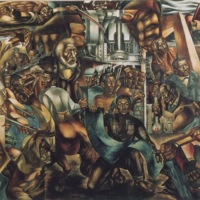![Aaron Douglas, Education of The Colored Man, WPA mural, Atlantic City Housing Project, Holmes Village, New Jersey, 1938 [now destroyed].jpg Aaron Douglas, Education of The Colored Man, WPA mural, Atlantic City Housing Project, Holmes Village, New Jersey, 1938 [now destroyed].jpg](https://486312.frmmmguz.asia/files/square_thumbnails/15f36a75369345850036ab75f68edbfe.jpg)
Education of the Colored Man
In 1938, Aaron Douglas returned to Fisk University as an assistant professor of Art Education, and it was during his summer there that he, under the aegis of the Treasury Department’s Treasury Relief Arts Projects, created the mural Education of the Colored Man, for the Atlantic City Holmes Village Housing Project in New Jersey. The mural depicts a young Frederick Douglass standing before a small crowd—a civil war solider, a former slave, a sharecropper and a seamstress—who listen to his words. Behind them is a growing metropolis, representing the industrial expansion of the urban north. The art project was funded by the Treasury Relief Arts Project (TRAP) and the Works Progress Administration (WPA).

The Contribution of the Negro to Democracy in America
In 1941, the artist Charles White was awarded $2000 from the Julius Rosenwald Fellowship for an ambitious project that included the creation of Contribution of the Negro to Democracy in America. Two years later, he unveiled the mural at the Hampton Institute in Virginia.The central figure has chains around his wrists that also loop around the necks of three other figures. But the shackles on the figure’s wrists are ready to be broken by the abolitionists: Frederick Douglass, Nathaniel Turner, Denmark Vesey, Harriet Tubman and Peter Still.